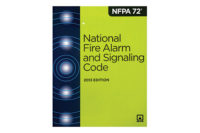Recent changes to commercial fire alarm system codes have driven changes to fire panels, impacting how the panels communicate with the central station. Although some authorities have not yet adopted the latest codes, it’s a good idea for security integrators to be familiar with the latest requirements.
New Communications Options
For decades, fire systems relied on two phone lines for communications, with communications checked for correct operation every 24 hours. But advances in Internet protocol (IP) communications — using either a cellular data network, a private wireless system or a landline network — have created new communications options at the same time that they have caused many businesses to move away from traditional phone lines, also known as POTS lines (plain old telephone service).
The 2013 version of the National Fire Protection Association National Fire Alarm and Signaling Code 72 recognizes these changes and offers new fire system communications options. Perhaps the most important change is that it allows systems to use only a network connection, only a cellular data connection or only an approved private wireless connection for communications, provided that the connection is supervised every hour, according to sources interviewed for this story. (Some people use the “IP” acronym to designate landline network connectivity, but it’s worth noting that cellular data connections also use IP communications.)
Previously the NFPA code offered a single-communications link option, but supervision had to occur every five minutes — a frequency that in some cases made those options cost prohibitive, explains Brandt Phillips, director of commercial fire and security sales for Amityville, N.Y.-based manufacturer Napco Security Technologies.
Now check-in times have been reduced to a “more realistic and cost-effective threshold,” Phillips observes.
When the check-in requirement was every five minutes, cellular service costs were substantial. But with the less frequent check-in requirements, the communications cost is now about 20% of what it was previously, Phillips explains. He also notes that 24 times a day is better protection than a phone line would ever provide.
Customers opting to convert to network, cellular data or private wireless communications for fire systems typically can eliminate at least one phone line. (NFPA rules for the two-line option allow one of the lines to be used for traditional voice service and customers using that option may want to keep that line.)
The cost of a phone line varies, but according to Lew Kramer, applications solutions designer for Springfield, Mo.-based manufacturer Digital Monitoring Products (DMP), it typically runs in the range of $70 a month. In comparison, a customer typically pays about $40 to $50 a month for the cellular connection underlying a fire system, Kramer says. And if the customer opts for a landline network connection, connectivity comes virtually for free.
Kramer recommends integrators choose cellular connectivity rather than landline connectivity, however, arguing that it is more reliable.
“You don’t have to worry about vandalism or people cutting phone lines,” he observes. He also notes that in the event of an earthquake or other natural disaster, an individual cell tower might be put out of commission, but the system would still have communications via a different tower.
Integrators that have held off on moving to network, digital cellular or private wireless communications for fire could soon be forced to do so, depending on which version of the NFPA code local authorities adopt, Kramer notes.
The reason is that the 2013 version of NFPA 72 makes it more difficult to use the traditional two-phone line approach than it was in the past, he explains. “They’re only allowing two POTS lines if no other service is available.”
Additionally the 2013 version of the code calls for those lines to be supervised every six hours. The system is required to alternately check the two lines at six-hour intervals, with the net result that each line is checked every 12 hours, explains Kramer.
Retrofits
Initially integrators installed network, digital cellular or private wireless communications primarily for new fire systems or when they had to replace a panel. But more recently a substantial market has developed for add-on modules that work with existing panels.
The challenge that these devices must address is how to convert traditional communications protocols designed for communications over a phone line to instead use IP. Manufacturers use various options to achieve this.
“We communicate with a traditional dialer using a capture card,” explains Richard Conner, director of marketing for Northford, Conn.-based manufacturer Honeywell Safety Products, The company’s add-on communicator can use digital cellular or network communications. The capture card “takes information from the DACT [digital alarm communicator transmitter] and translates it into something that can be communicated over IP or cellular,” Conner continues. “You’re still sending contact ID but in a different way. You can simply add it and the fire panel will think it’s talking to a central station over phone lines.”
Napco also uses dialer capture technology for its add-on digital cellular communicator. “We support both contact ID and 4+2 formats, which ensures that we not only support new panels but also older systems.” Phillips explains.
In addition to offering addressable and conventional fire panels with IP communications capability, Potter Electric Signal also offers a small conventional panel with network communications capability that some integrators use in combination with other manufacturers’ panels to monitor their systems, notes Craig Summers, national sales manager for St. Louis-based manufacturer Potter Electric Signal.
That product works by tying in relay outputs from the other manufacturer’s panel to zones on the Potter panel, Summers explains.
DMP offers a choice of add-on digital cellular or network communications modules that can support either of the options that Conner and Summers describe. Additionally either of the modules can use the audio cadence outputs as triggers for the communicator, Kramer explains. “If we get temporal 3 we send fire; if we get temporal 4 we send a CO [carbon monoxide] alert.” (Read more about these audio requirements on page 88.)
Kramer also notes that the DMP communicator can be powered from the fire alarm control panel, eliminating the need to add a separate power supply for the communications module — although integrators will need to take the communicator’s power requirements into account when doing standby battery calculations.
It’s worth noting that if integrators prefer, they typically can use the digital cellular or network communications capability of add-on devices such as those discussed here as a back-up to another technology rather than as the sole communications device.
Retrofit add-on communications options are seeing strong sales, in part, because customers are becoming concerned about their reliance on traditional phone lines now that telephone companies, with some support from the FCC, hope eventually to phase out traditional phone service. Additionally some existing fire systems use second-generation wireless as one form of communications and customers with those systems will be forced to make a change, as some wireless carriers have announced that they will no longer support second-generation wireless communications after a certain date.
Phillips says end users should see a payback of eight to 18 months in phone line cost savings.
Integrators wanting to pursue retrofit opportunities should note, though, that add-on fire alarm communications modules and panels may only communicate with certain central station receivers. They should check with the manufacturer for details.
Modern fire alarm communications options not only can save money, they also can provide a higher level of assurance that communications are available when needed. And with new retrofit options, integrators can easily add modern communications options to existing fire systems. Those who have not yet begun to offer these options should seriously consider doing so.
New Audio Requirements
Another important change in the 2013 version of the NFPA code is a new requirement for sounders and speakers to support a lower-frequency temporal 3 tone — the tone used for fire alarms to distinguish them from other types of alarms, including carbon monoxide alarms, which use a tone known as temporal 4.
“Independent studies found that the low-frequency tone could awaken those with hearing impairment in the event of a fire alarm,” explains John Gallo, fire product manager for Toronto-based manufacturer Mircom.
This capability drove some new requirements for fire panels supporting emergency communications, Gallo notes. The reason is that audio tones for the speakers used with emergency communications are generated in part by the fire panel. If the speakers are also used for fire alarms, the panel has to be able to provide an appropriate low-frequency output for the speakers, he says. For systems that use sounders, horns or horn/strobes, those devices or the sounder bases handle the task of providing the appropriate signal, Gallo notes.





